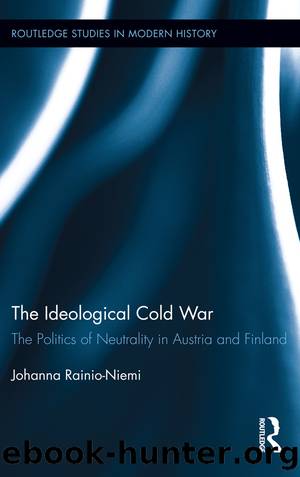The Ideological Cold War by Johanna Rainio-Niemi

Author:Johanna Rainio-Niemi [Rainio-Niemi, Johanna]
Language: eng
Format: epub
Tags: History, Europe, General, Austria & Hungary, Scandinavia, Modern, 20th Century
ISBN: 9781135042400
Google: Gm3MAgAAQBAJ
Publisher: Routledge
Published: 2014-02-05T16:02:10+00:00
Pluralist Readings of the Nation
Searching for guidelines to a new national ideology, the HMP committee set out to find out what were the core values of society and the state in Finland. These core values ought to be the ones that were shared by the citizens and ones that the people were ready to vindicate under all circumstances. In order to appeal to the people, the new national ideology must build upon values that the people were holding dear. The committee took as its tasks to identify such a common national âwavelengthâ and, then, on this basis, formulate a concrete policy program that would make the new guidelines for national opinion-building known and approved among the citizens.
To find out the scientifically precise common wavelength among the people, the committee commissioned an external investigation from a youngergeneration sociologist Antti Eskola (1962a, 1962b)5. Eskolaâs aim was to analyze the values and attitudes that underpinned the individualâs will to keep up and defend his/her own state and the order of its society. The empirical basis of this scrutiny was the same opinion survey data that had been used by Jaakko Valtanen in 1954. Eskola viewed this data through the lenses of most recent social psychological theories on group solidarity, and, what Valtanen had called âthe spirit (and will)â to national self-defense, was thus framed by Eskola as attitudes of group loyalty and will to defend the order of society.
According to Eskola (1962a, 1962b), his focus was on the attitudes which in everyday parlance were typically referred to as affection or devotion to the nation and fatherland. From a social psychological perspective, the devotion to the nation and the fatherland could be treated as a form of belonging to a certain group and as expressions of oneâs will to belong to this group. In analytical terms, a nation was âjustâ a group among other social groups and, respectively, carried and upheld by the individualsâ continuous decision to belong, to maintain, and defend this particular group. The more attractive the group was conceived, the stronger was the wish to belong to it and, also, to defend it.
This approach led to a modern, âpluralistâ understanding of the nation and patriotism that was in contrast to the traditional understanding of the nation as an organic collective. The latter was based on heroic, emotionally loaded narratives of collective national history, expecting that individual citizens would always place the nationâs cause above their own interests and possible other group loyalties. In line with the modern understanding, however, the question was not what an individual could do for the nation but, equally importantly, what could a nation do for its citizens. This type of thinking would improve the nationâs attractiveness in the eyes of its citizens and, respectively, lead to a sound and solid will to defend society, its political, economic, and social order (Eskola 1962b).
The single most cited aspect in Eskolaâs study became the typology of patriotic attitudes and, especially, the type of âpatriotic pacifistâ that he singled out (cf.
Download
This site does not store any files on its server. We only index and link to content provided by other sites. Please contact the content providers to delete copyright contents if any and email us, we'll remove relevant links or contents immediately.
Room 212 by Kate Stewart(5041)
The Crown by Robert Lacey(4731)
Endurance: Shackleton's Incredible Voyage by Alfred Lansing(4683)
The Iron Duke by The Iron Duke(4293)
The Rape of Nanking by Iris Chang(4139)
Joan of Arc by Mary Gordon(4017)
Killing England by Bill O'Reilly(3953)
Say Nothing by Patrick Radden Keefe(3904)
I'll Give You the Sun by Jandy Nelson(3362)
Shadow of Night by Deborah Harkness(3308)
Hitler's Monsters by Eric Kurlander(3269)
Mary, Queen of Scots, and the Murder of Lord Darnley by Alison Weir(3152)
Blood and Sand by Alex Von Tunzelmann(3140)
Darkest Hour by Anthony McCarten(3072)
Eleanor & Park by Rainbow Rowell(3063)
Margaret Thatcher: The Autobiography by Thatcher Margaret(3029)
Red Famine: Stalin's War on Ukraine by Anne Applebaum(2874)
Book of Life by Deborah Harkness(2869)
The One Memory of Flora Banks by Emily Barr(2803)
